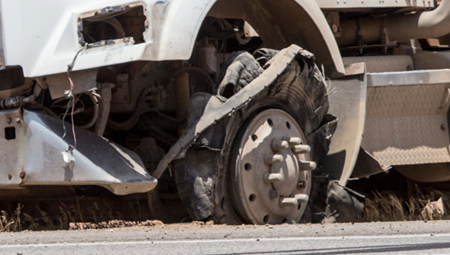Everyone seems to think tire blowouts are an acceptable part of doing business. Firstly, they are extremely costly and time wasting. And they can be very dangerous- watch this crash caused by a blowout. A blowout usually occurs along the interstate, far away from tire repair shops. If the blowout is bad enough, it can blow the other dual off the rim and damage it too. I’ve had that happen before. By the way, that was a $1300 blowout. Two Michelins, a road side assistance call and on a weekend. Cha-Ching!
It was then that I thought, there has to be a better way. I found out about Truck System Technologies and they have been my supplier of choice for the last two years. During the two years I’ve had this system, I’ve had ZERO blowouts and haven’t lost a tire yet. The TST monitoring system has a 36 tire industrial grade monitor with antenna, repeater and comes with six sensors that measure pressure and temperature. Since I always pull the same trailer, I ordered more sensors in order to have all 18 tires monitored.
Besides guarding against blowouts, you can maintain  optimal tire pressure with this system. A tire can heat up 20 psi each day, depending on the temperature and weight of the load on the tire. It’s important to make sure your tires have the correct cold pressure before you roll out. You may begin your day with a tire that’s 100 psi, then as the day goes on, it expands to 115 psi. This tire is not inflated for optimal fuel mileage. Now imagine you’re around 100 psi on all 18 tires. If you would inflate them all to their usual maximum of 120 psi, it would be an increase of 360 psi of air that your truck and trailer would be riding on. That would remove a lot of rubber from touching the road, thus reducing resistance and therefore increasing fuel mileage.
optimal tire pressure with this system. A tire can heat up 20 psi each day, depending on the temperature and weight of the load on the tire. It’s important to make sure your tires have the correct cold pressure before you roll out. You may begin your day with a tire that’s 100 psi, then as the day goes on, it expands to 115 psi. This tire is not inflated for optimal fuel mileage. Now imagine you’re around 100 psi on all 18 tires. If you would inflate them all to their usual maximum of 120 psi, it would be an increase of 360 psi of air that your truck and trailer would be riding on. That would remove a lot of rubber from touching the road, thus reducing resistance and therefore increasing fuel mileage.
If you run over something on the interstate and start losing air pressure, the monitor will sound an alarm of the event. Instead of pulling off on the shoulder, look for a better place to get off the road like a rest area, truck stop or even an exit ramp. When you catch the loss in pressure immediately, there’s time to get off the interstate safely as long as you slow down (which cools the tire) and monitor the pressure as you look for a safe place to park. If it is a slow leak, you can find a nearby tire shop and drive to them, thereby avoiding a service call. If it’s a fast leak, you can use a commercial tire plug and a gladhand airline and pump up the tire enough to limp it over to the nearest tire shop for proper repair. This avoids a service call and the very costly expense of ruining and replacing a tire.